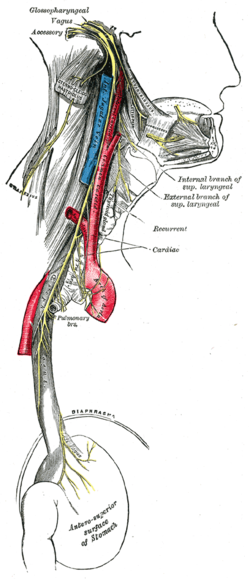| Vagus nerve | |
|---|---|
 Plan of the upper portions of the glossopharyngeal, vagus, and accessory nerves. | |
 Course and distribution of the glossopharyngeal, vagus, and accessory nerves. | |
| Details | |
| Innervates | Levator veli palatini, salpingopharyngeus, palatoglossus, palatopharyngeus, superior pharyngeal constrictor, middle pharyngeal constrictor, inferior pharyngeal constrictor, viscera |
| Identifiers | |
| Latin | nervus vagus |
| MeSH | D014630 |
| NeuroNames | 702 |
| TA98 | A14.2.01.153 |
| TA2 | 6332 |
| FMA | 5731 |
| Anatomical terms of neuroanatomy | |
| Cranial nerves |
|---|
|
The vagus nerve (/ˈveɪ.ɡəs/), also known as the tenth cranial nerve, cranial nerve X, or simply CN X, is a cranial nerve that carries sensory fibers that create a pathway that interfaces with the parasympathetic control of the heart, lungs, and digestive tract.[1]
It comprises two nerves—the left and right vagus nerves, each containing about 100,000 fibres—but they are typically referred to collectively as a single subsystem.
The vagus is the longest nerve of the autonomic nervous system in the human body and comprises both sensory and motor fibers. The sensory fibers have their nuclei either in the jugular or the nodose ganglion, whereas the motor fibers come from neurons of the dorsal motor nucleus of the vagus and the nucleus ambiguus.[2] The vagus was also historically called the pneumogastric nerve.
- ^ Prescott SL, Liberles SD (February 2022). "Internal senses of the vagus nerve". Neuron. 110 (4): 579–599. doi:10.1016/j.neuron.2021.12.020. PMC 8857038. PMID 35051375.
- ^ Walker HK (1990). "Cranial Nerve XI: The Spinal Accessory Nerve". Clinical Methods: The History, Physical, and Laboratory Examinations (3rd ed.). Butterworths. ISBN 9780409900774. PMID 21250228. Retrieved 30 May 2019 – via NCBI Bookshelf.